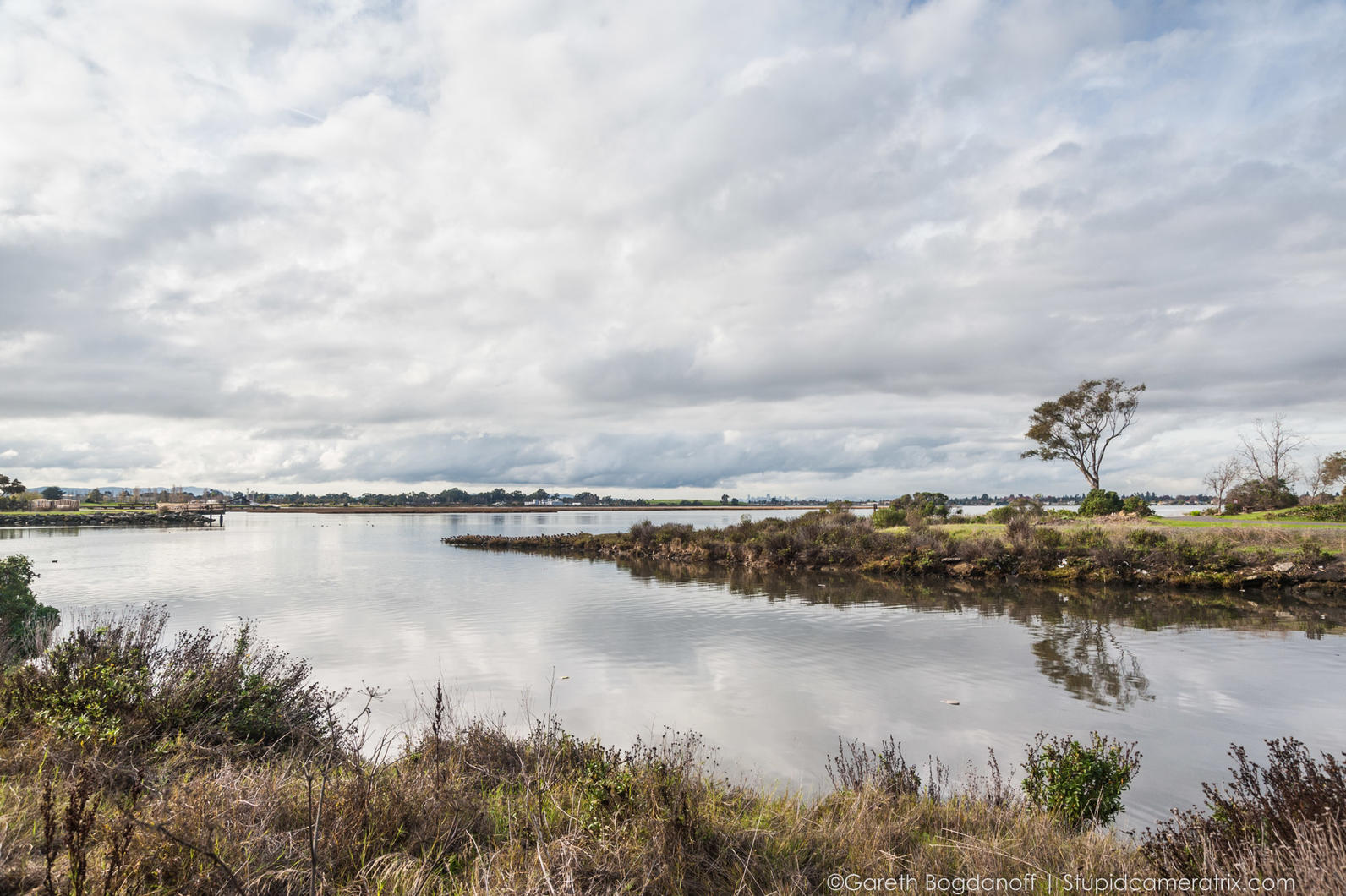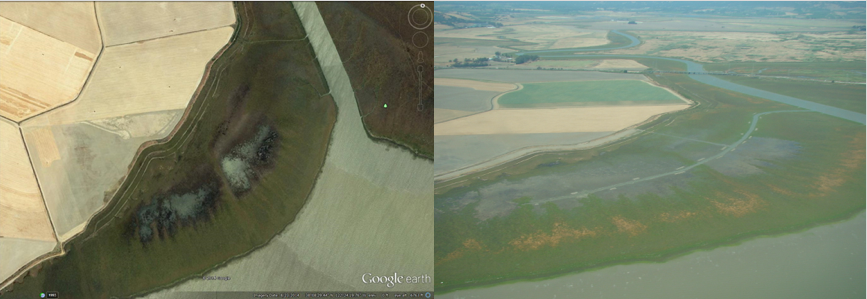Black Oystercatcher
Latin: Haematopus bachmani
Audubon is advancing nature-based strategies to help coastline communities weather the impacts of climate change.
Overhead Shot of Aramburu Island
Coastal resiliency is a community’s ability to rebound after an extreme weather event. Resilient, healthy coastal ecosystems serve as the first line of defense for coastal communities facing stronger storms, more frequent flooding, and sea level rise. These resilient coastal ecosystems, in turn, greatly benefit bird communities. Audubon is advancing nature-based strategies to help coastline communities weather the impacts of climate change.
Audubon’s conservation, policy, and science teams prioritize potential restoration sites in and around socially vulnerable communities to protect both birds and people where they are at highest risk from sea level rise.
Aramburu Island is a 17-acre human-made island located in Richardson Bay. The island was created in the 1960s from the dredge spoils from a nearby boating channel. Over many years, the unmanaged island became host to a wide variety of non-native and invasive plants and the banks significantly eroded due to wave action.
In 2007, after the Cosco-Busan oil spill, Audubon California staff observed a large percentage of birds in Richardson Bay were using Aramburu Island as refuge from the toxic waters. This observation led Audubon California to designate Aramburu Island as critical bird habitat and quickly made plans for an enhancement project.
The Enhancement Plan improved aquatic, wetland, and upland habitats for a range of local species, stabilized the rapidly eroding eastern shoreline, and helped the island and surrounding communities adapt to sea level rise. Since the completion of construction in 2012, thousands of native plants have been installed and hundreds of adult and youth volunteers have contributed thousands of hours restoring and maintaining the island. Today, Richardson Bay Audubon Center & Sanctuary staff host restoration workdays where volunteers can actively contribute to this ongoing restoration success.
Sonoma Creek runs from Sonoma County into the San Pablo Bay on the northernmost end of the greater San Francisco Bay.
The California Gold Rush caused a rapid increase in human population across California. During this time, mining and agricultural practices skyrocketed, causing a devastating effect on one of California’s most sensitive ecosystems- coastal wetlands. In the San Francisco Bay Area, Sonoma Creek marsh displays the scars of these practices- poor hydrology that causes stagnant pools and form algal mats, harbor mosquitos, and suppress native vegetation as well as steep levees, which cut off the natural movement of plants, animals, and water.
Audubon California partnered with the Marin-Sonoma Mosquito and Vector Control District and the San Pablo Bay National Wildlife Refuge to restore this wetland to its highest potential. The core of the project involved constructing a network of tidal channels within the marsh to drastically improve tidal exchange, nutrient cycling, and provide habitat to a myriad of marsh-dependent wildlife species. The channels provide spawning and feeding grounds for endangered and commercial fish.
Improving hydrology improved water quality by increasing circulation and drastically reducing the amount of pesticides applied to areas of ponded water that currently facilitate heavy mosquito production. The project also had a vital climate change adaptation component. The construction of a gently-graded high marsh transition zone reduced storm surge flooding of adjacent private lands and provide crucial high tide refuges for rails and small mammals.
A string of lagoons can be found along the coast of San Diego County, providing unique habitat for migrating birds, protecting communities from storms and sea level rise, and sequestering large amounts of carbon. However, two major sites, Buena Vista Lagoon and Mission Bay, remain impacted from development. Audubon CA, Buena Vista Audubon, and San Diego Audubon are working together with local community and indigenous partners to restore these impacted areas through hands on restoration events, storytelling, and advocacy.
Through this community-driven project, we will work together to heal these lagoons and ensure that they become healthy and thriving ecosystems for people and birds.
Audubon is the voice for birds from Town Halls to the U.S. Capitol. We will bring the full power of our expansive network to bear on behalf of the most important policies that will lead to protection for birds, ecosystem restoration and resilience, and healthy coastal habitats.
Leverage our science expertise and Audubon network to advocate for investment in nature-based climate solutions, such as wetland and eelgrass restoration.
November marks the 10-year anniversary of the Cosco Busan oil spill in San Francisco Bay. With that in mind, we recently revisited our restoration project on Aramburu Island in Richardson Bay that was largely inspired by the disaster. We're happy to report that the birds are responding well to the newly created habitat.

News of proposed budget cuts at the Environmental Protection Agency bode ill for conservation in San Francisco Bay and San Diego, as two major programs are on the chopping block.
In San Francisco Bay, the EPA looks to cut its entire $4.8 million budget for clean water and wetlands restoration programs. This is particularly bad news, as San Francisco Bay has never received a proportionate share of federal restoration funding.
Last year, residents of Bay Area communities approved Measure AA, which will raise about $500 million over the next 20 years for wetlands restoration. Leaders had intended to use this money to leverage greater investment from the federal government.
The EPA is also proposing to cut the $3 million it spent last year on cleaning up pollution in the Tijuana Estuary down to $275,000. This area is the last remaining large wetland in Southern California, and is an Important Bird Area. Endangered Ridgeways Rails and Light-footed Rails make great use of the area.
In addition to cuts specifically targeting California, we also learned of proposed cuts that will go into effect nationwide, but will certainly impact things we Californians care about, such as gutting programs that test coastal water quality, educate our children about nature, address climate change, and reduce pollution in communities suffering the most.
Please raise your voice against these cuts by sending an email to your members of Congress.

Courtney Gutman got an aerial view of the progress made at our Sonoma Creek enhancement project which we completed in November. Gutman is our restoration project manager from the Richardson Bay Center & Sanctuary and oversaw construction on the 400-acre tidal marsh in the greater San Francisco Bay.
Within weeks of finishing the construction, the team could already see a myriad of vegetation and wildlife coming back to the area, including a variety of small shorebirds and pickleweed, a native succulent that absorbs saltwater.
The Sonoma Creek enhancement is the first project of its kind on a pre-existing marsh. Before the project, sea water was able to wash in during high tide, but with no way for it to drain, stagnant pools became perfect breeding ground for mosquitoes and an imperfect breeding ground for plant life and other animals. To solve this problem, we dug canals to help with drainage of the area. Natural channels can now form in areas that were once stagnant, contributing to a healthier marshland. We also moved about 30,000 cubic yards of soil to create a transition ramp that slows storm surges and gives animals somewhere to go when the tide gets too high.
Gutman says people are starting to see estuaries beyond their importance for wildlife, plants, and biodiversity.
“Now on top of that we’re seeing how important they are for combatting climate change. They’re truly our natural barriers for rising sea levels,” she says.
For more information about the project, visit our Sonoma Creek page.
Our newsletter is fun way to get our latest stories and important conservation updates from across the state.
Help secure the future for birds at risk from climate change, habitat loss and other threats. Your support will power our science, education, advocacy and on-the-ground conservation efforts.
California is a global biodiversity hotspots, with one of the greatest concentrations of living species on Earth.